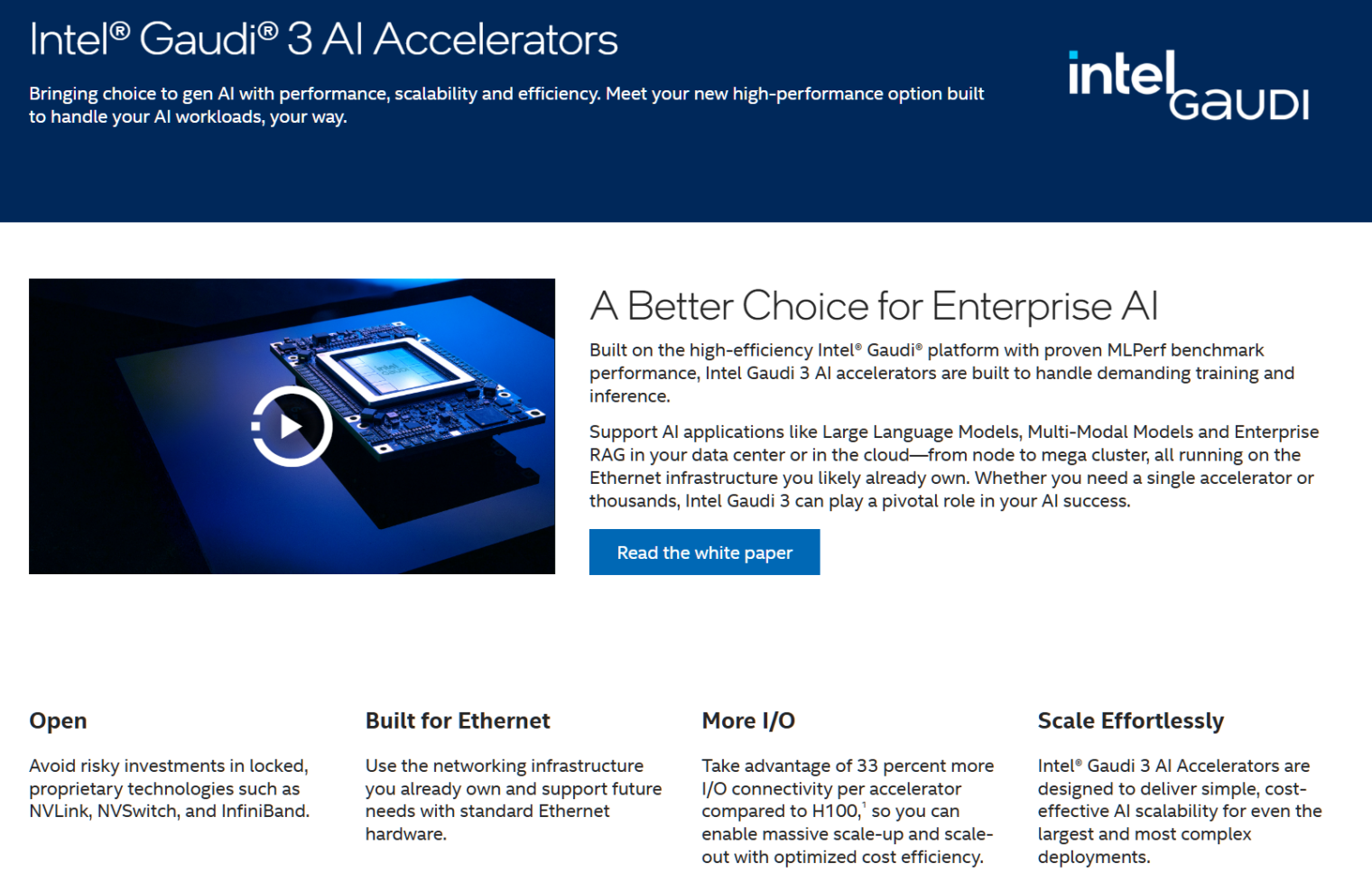It’s been about six months since a Chinese guy took over at Intel from the white male who said that his primary passions were mostly peaceful BLM protests, giving big jobs to women and people with dark skin, etc. (And nine months since the white savior BLM warrior was ousted.) Has Lip-Bu Tan managed to turn the company around? At least with a dead cat bounce?
I still would like to know why Intel’s Gaudi chips are such a failure compared to NVIDIA. They sure sound great in HTML (replacement phrase for “on paper”):
Did Pat Gelsinger follow his BLM and DEI passion into a full-time job at a social justice enterprise? Apparently not. Investors who suffered a 75 percent loss on Intel stock (adjusted for Bidenflation) during the white savior’s leadership of Intel now have the opportunity to lose some more money by giving it to Playground Global, a venture capital fund where Gelsinger is a partner.
Is it too soon to do an INTC v AMD stock price chart? Maybe not! Remarkably, now that the Social Justice Warrior is out, INTC has actually outperformed AMD over the past year:


Porting AI models from NVidia to the millions of other platforms is hard. Nvidia was 1st to the party in 2004 when everyone else was investing in web 2.0.
SGI invented the 3D z-buffer workstation, software and hardware, 1st to the party. WinTel came along with a cheaper, worse is better solution:
https://en.wikipedia.org/wiki/Worse_is_better
Who was SGI again? In with the “Jurassic Park” dinosaurs (another market they were early into).
Faster PC is not mission critical for 99.9% of PC market buyers. PC runs office applications, web browser and games. In personal computer industry, threshold of over-engineering is relatively small.
Speed of AI chip is mission critical to all buyers.
The real comparison on the topic of A.I. for “worse is better”, is between artificial brains and human ones.
@perplexed
“Faster” is kind of a nebulous concept, along with the related “efficiency”–seems like the overall perception of customers is the biggest factor. Benchmarks are often more marketing than science. How do you benchmark A.I. voodoo? Even old school computing is hard to definitively benchmark on the new CPU designs, with pipelining, caching, etc. A lot of voodoo there too. I don’t really keep up with A.I. chips either, so this is more of a general comment about how far one can go with marketing, rather than how Intel currently is doing.
@Trust sceptic, faster I refer to is quicker time to train of same models on unbelivingly (and unnecessary, per Vapnik’s crtique of deep learning) huge datasets they use. More efficient I reffer to is smaller dollar amount spent on electricity to run and cool GPUs required for training same models. Per prior Philip’s post, at some point in the next decades AI server farms are going to run out of available electrical power, if nothing changes.
I used to build electric chains, networks, radioelectronics, upgrade PCs and code on processor, RAM, and direct HD access levels, but most of my experience is developing abstract models, software and processes. Do not really follow processor benchmarks any longer, but review them from time to time. For me faster and more efficient is at the application or overall final result level.
If Intel’s AI chip was one or more of following: faster, cheaper, more energy efficient then NVIDIA’s GPU then LLMs would have been ported to it fast. Intel needs to come up with its own code porting model for copilot and similar tools. I am not following the chip race and can not compare Gaudi to NVIDIA GPU.
Did they release anything after Gaudi 3? It seems so long ago since Nvidia releases something new every year. AMD chips sound impressive in HTML as well but I don’t know if anyone uses them. Maybe losing to Nvidia is not unique to Intel.
It seems that all big companies are trying to make their own chips, like Google TPU. For smaller players, probably Nvidia alone is enough, porting to something else requires too much effort. Maybe the Chinese companies will all move to Huawei or something but it’s unlikely they will prioritize Intel.
Bring back WinTel? That was a highly profitable association. MS with Gaudi Inside [TM]
For readers that didn’t struggle writing compilers with 8 general purpose registers on the 32 bit Pentium, vs. the 32 on the 32 bit PowerPC–the punch line is that Intel managed to capture the market somewhat despite the hardware, not because of it.
And like how MCAS could be considered inferior to changes in geometry of airframe/wings to accommodate large high-bypass engines on certain already designed planes. *Effective* marketing is the key–DEI seems to be weighted less in that during its current downturn.
Of course, by the time 64 bit Intel chips like the Core Duo came along, the PowerPC just couldn’t keep up with the energy efficiency, etc., of Intel, so even Apple used them for a while. Maybe IBM didn’t invest enough money to keep up.
For those of us who know very little about the inner workings and trajectory of the AI technology, wondering how all of you experts here (appears to be a bunch) see things evolving in the next 5 years. Big, broad question, I know… Interested in any and all speculation.
Related news: market cap of NVidia ($6T CAD) just surpassed combined market cap of all stocks in Canada ($5.3T CAD).